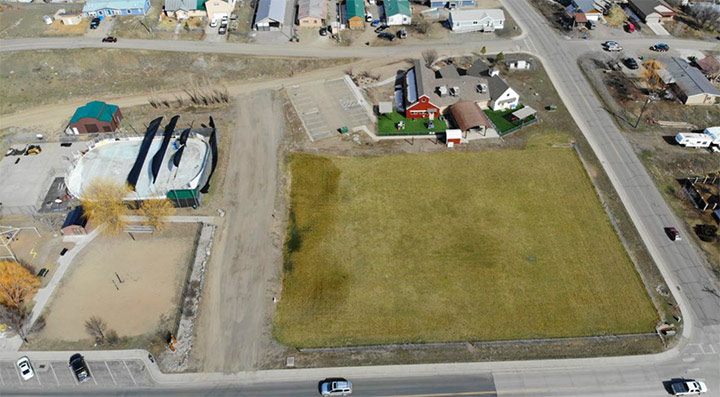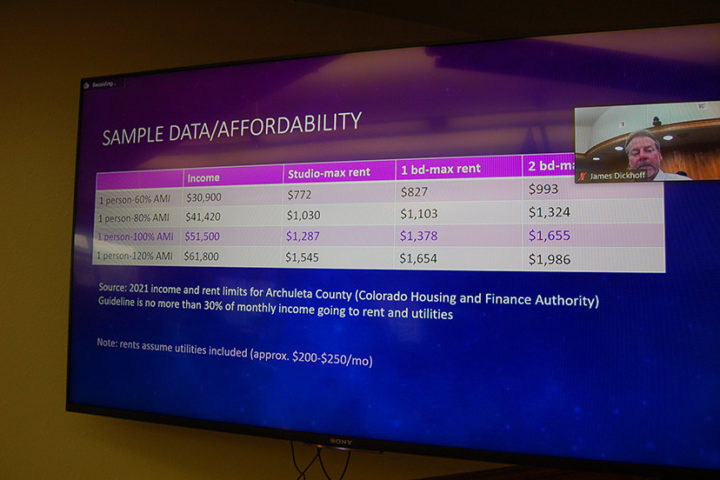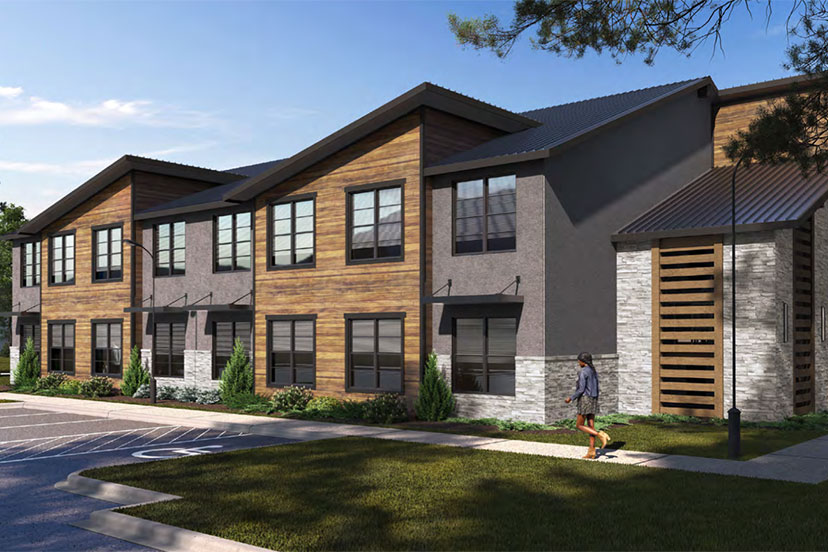The first item to be debated, at the Tuesday, April 12, Town Planning Commission meeting was the proposal to use about one-third of South Pagosa Park as the site for a 28-unit apartment building… which might, or might not, look something like the photograph shown above.
However the building might look… it might, or might not, be located at the northeast corner of South Pagosa Park.
Really, it was the only agenda item that generated much debate at all on Tuesday.
The first iteration of this proposed apartment building showed it replacing an existing grassy playing field — shown in the following photo at the bottom right, in the Park’s southwest corner — that’s is used regularly by neighborhood children and families, including the families involved with the Seeds of Learning Early Education Center, shown at the top right…

That first iteration, Option A, proved highly unpopular with the community during neighborhood meetings between the Town staff and the neighborhood residents. As was pointed by a couple of folks who testified at Tuesday’s Planning Commission meeting, the Town government has, in years passed, made a couple of attempts to convert dedicated park properties to ‘commercial’ uses, and both of those attempts were defeated by citizen referendums.
How likely is it, that this attempt would also be defeated — if the Town attempted to replace a grassy playing field with workforce housing? Good question.
So the Planning Commission was presented with Option B, which showed the apartment building replacing the existing pickleball courts and ice rink at the northeast corner of the park — basically, a cracked concrete pad that had served, years ago, as a skate park, and before that, as basketball courts… although it maybe have been built, originally, to be tennis courts?
The proposed apartments, as presented in Option B, would extend across the existing 7th/8th Street Alley, eliminating what has been a popular transportation route for the surrounding neighborhood.

The dynamics of Pagosa Springs economy, and the rules and regulations promulgated by our local governments, have discouraged the construction of one- and two-bedroom apartment units. Meanwhile, the construction industry has, for the past 20 years, been focused on retirement homes and ‘second homes’ — stick-built single family homes, generally priced beyond the financial reach of our low-paid workforce.
Here, we are listening to community resident Mark Bergon, one of the local activists who helped initiate South Pagosa Park 25 years ago, addressing the Commission.
“First of all, I want to commend all of you, for seeking to improve our housing situation, by making it more affordable for working people. This is a huge problem, not only locally, but regionally…
“I come to you to ask you to exempt South Pagosa Park as a location for building such a needed facility. I have an innate affection for parks and park-like settings… I’ve always rated cities according to their park system…
“Back in the 1990s, it was my privilege to be part of a small group that was hoping to build a park on vacant land in South Pagosa. Eventually, many more people became involved, and the dream became a reality.
“It’s unfortunate that parks and public land, whether local or national, are always seen as fair game for development…”
Some other folks who spoke at the meeting, including a couple of the Planning Commissioners, agreed with Mr. Bergon’s basic premise, which was that parks — being ‘vacant land’ — are easy game as development sites, and therefore require diligent protection.
But the Commission as a whole favored using the northeast corner of the park as the location for 28 units of ‘workforce housing’, and in the end, the Commission voted 4-to-1 to direct the staff to work with Servitas, and bring forward an improved design for the project that would preserve the 7th/8th alley.
I’ve been advocating, personally, for community-supported workforce housing since at least 2016, when I served on the Archuleta County Housing
The issue that continued to pester me, personally, is not whether the 64 proposed Servitas apartments will end up getting built, or where, exactly, they would be located, but rather… how much will they cost to rent?
I’m thinking back to the year 1993 — a year that stands out in my memory, because the year Clarissa and I moved to Pagosa with our three kids, to explore life in a funky Colorado mountain town. For some reason, the weekly Pagosa Springs SUN was listing very few rentals that summer, and we ended up in tiny, one-bedroom house, just down the street from the Spa Motel (now, the Healing Waters Resort), paying what we thought was scandalous rent:
$450 a month.
Outrageous, even if the rent did include most of the utilities.
Granted, this rustic little house — I’m guessing it was about 580 square feet? — included a back yard right on the San Juan River, so I could walk out my back door and catch a trout for dinner. The rent just seemed awfully high, at 75 cents per square foot.
But we didn’t really have much choice in 1993… or so it seemed. The rental market was really tight.
I checked an inflation calculator yesterday, to see how much that same 580-square foot home might rent for today, if that same outrageous rent had kept pace with inflation. (And if the house hadn’t been torn down to make room for condominiums.)
With inflation, it would rent for $895 a month.
Below is a slide shared by Town Manager Andrea Phillips at the beginning of the Planning Commission meeting. (For some reason, we can see a video image of Town Planning Director James Dickhoff in the corner, as if he were considering the dollar amounts.)
Looking at the rents which will apply to the three proposed Servitas workforce housing developments, if they get built as planned…

As I understand the proposed project, Servitas is a for-profit partnership, so they want to make sure their three “P3” projects here in Pagosa generate a profit.
The cozy little one-bedroom apartment units they are proposing will apparently measure about 580 square feet, and will rent for “80%-120% of AMI”, including certain utilities.
That is to say, for somewhere between $1,103 and $1,654 per month. So, then… maybe twice as much, adjusted for inflation, as the scandalous rent we paid for a 580-square-foot house on the river, in 1993?

